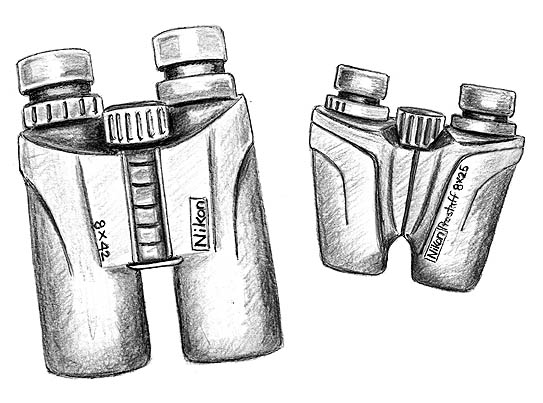
Dear Bird Folks,
I’d like to get a new pair of binoculars for my wife but I don’t know much about them. Any advice?
– Roger, Ludlow, VT
Good one, Roger,
Remember that old joke? One guy says, “I got a new pair of binoculars for my wife.” To which his friend replies, “Good trade.” Get it? It’s important to note that this joke is interchangeable, so don’t get upset with me, ladies. “Husband” could easily be substituted for “wife” and the joke would still work fine…it just wouldn’t be as funny. And let the record show, I don’t suggest anyone trade his or her spouse for a new pair of binoculars. That would be stupid (unless it’s a really good pair).
Looking over my bird diary, I see that I wrote about binoculars back in the spring of 2002. Apparently, you were out of town that day, Roger. Not to worry, I was due to write a new column on this topic. Binoculars are one of the few items that have actually improved over the years. Unlike some things, like, say, the airlines or tomatoes, the current batch of binoculars is better than their previous counterparts. I’m sure there’s some old guy out there who will disagree with me on this topic. He’ll insist the pair of binoculars that he “borrowed” when he was discharged from the military in 1953 is better than anything made today. Nope, they’re not. This is especially true when it comes to features. Newer binoculars tend to be waterproof, are eyeglass friendly, are lighter and are more ergonomic than the binos made years ago. No one can argue with this, especially since the word “ergonomic” didn’t exist in 1953.
I don’t know if there are any stores in Ludlow, VT, but my first advice to anyone looking for new binoculars is to find a place that carries several brands and styles, and try them all. More important than the numbers and statistics is how they feel in your hands and how they fit your eyes. I know we all love to shop online, but buying binoculars is like buying a new suit or a fresh pair of dentures; they really need to fit you correctly. It would be great if they made one pair of binos that was perfect for everyone but unfortunately it can’t be done. Some folks have big hands and others have tiny hands. Some people are fat heads while others are pin headed. “One size fits all” simply doesn’t work with binoculars, just like it doesn’t work with dentures. And believe me, I know about that last one.
Typically, binoculars come in seven, eight, ten or twelve magnification (written 7x, 8x, 10x or 12x). Ninety percent (written 90%) of what we sell is 8x. Why? Most folks feel 7x isn’t strong enough, while 10x and 12x are too strong. Too strong? What’s wrong with more magnification? High-powered binos often result in poor image quality because, believe or not, everyone’s hands shake a little, and that shaking is also magnified by 10x or 12x. Though it’s true that more magnification gives us a bigger image, an image that isn’t steady is usually more blurry and not more better.
Binocular manufacturers have made huge strides in producing binoculars for eyeglass wearers. If you wear glasses, look for binos with large eyepieces and deep, twist-down eyecups. These features allow birders to keep their eyeglasses on while birding and that’s important. Many newbies are tempted to remove their glasses but that’s a mistake. Strange as it may seem, eyeglasses improve our vision and isn’t that the point of using binoculars?
What should you pay for new binos? For looking at birds in the backyard, going to football games or checking out the hotties on the beach, a $100-ish pair is more than good enough. But anyone who goes on birding trips or takes regular bird walks should push that number up to $200-$300-ish. The higher price gives you improved optics, better images and less eyestrain, and makes you look like less of a loser to the other birders. But don’t go too crazy. Some optics sell for close to $3,000. Are $3,000 binoculars fifteen times better than a pair selling for $200? No, they aren’t. But they may be 10% better and for a field researcher that’s important. However, the rest of us can easily scrape by with a less pricey pair.
What about size? You’ll see binos advertised as 8×42, 8×32, or 8×25. The 8x is the power, while the number to the right of the “x” is the size of the front or objective lens. The higher that number the larger the binoculars will be. An 8×42 will be roughly twice as large as an 8×25. Which is better? Well, the 8×42 has some advantages, most notably the ability to gather more light through the larger lenses. But large binoculars can be simply too heavy for some folks. In that case, a smaller pair will be fine. Large binoculars are good, but not if no one wants to carry them.
My advice, Roger, is to take your wife to a shop that has a large selection of binoculars and let her choose her own pair. Or if you want to surprise her with a pair that you’ve picked out, just make sure they can be swapped in case she hates them. One last piece of advice: avoid buying “zoom” binoculars or “focus-free” binoculars. We don’t have enough time to discuss those awful things right now, but believe me they are bad. How bad are they? Let’s just say spending your money on a pair of those lame-o binoculars would be like investing in a video game company started by Curt Schilling. Enough said.